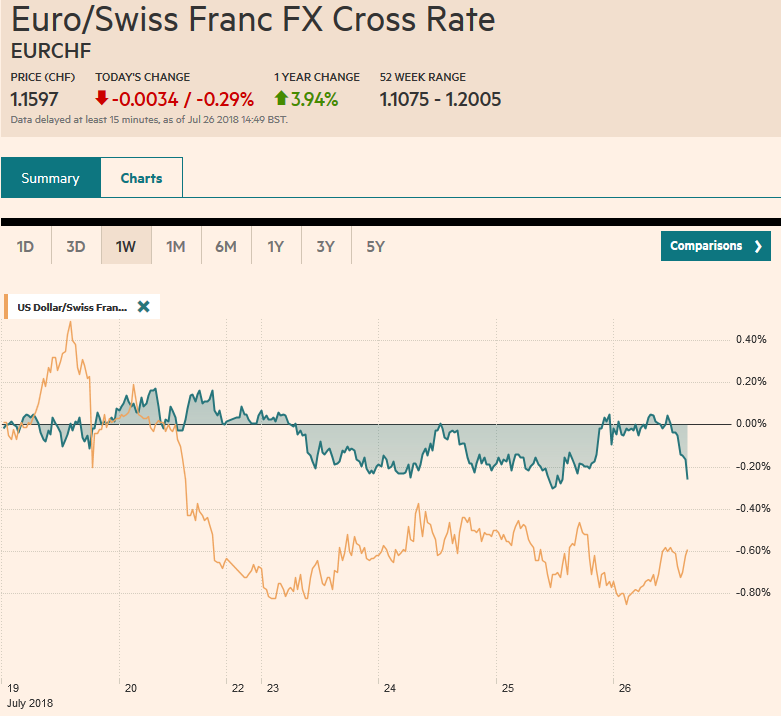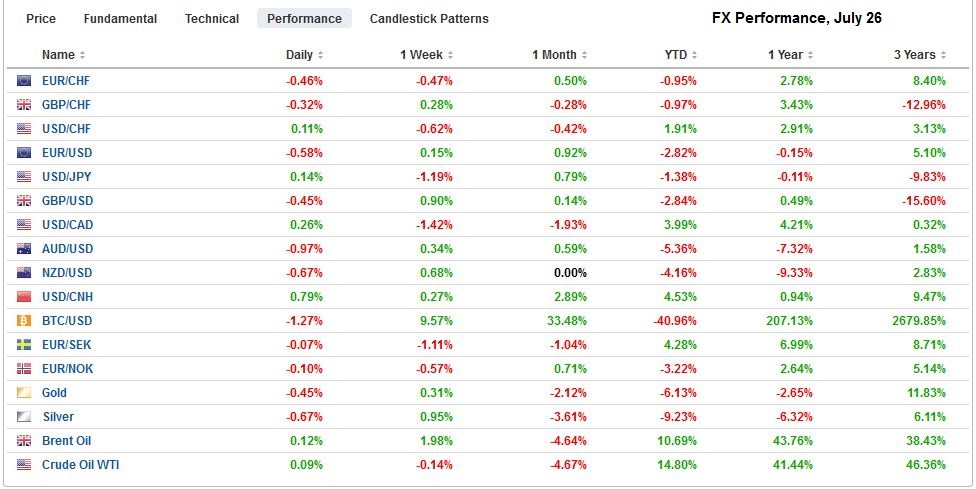Swiss Franc The Euro has fallen by 0.29% to 1.1597 CHF. EUR/CHF and USD/CHF, July 26(see more posts on EUR/CHF, USD/CHF, ) Source: markets.ft.com - Click to enlarge FX Rates The dollar is mostly firmer. The Australian dollar is off the most (~0.35%, ~%excerpt%.7425), after peaking a little above %excerpt%.7460. The price action reinforces the %excerpt%.7300-%excerpt%.7500 range. The yen is the strongest of the majors. Near JPY110.80, the yen is up about 0.2%. The dollar has extended its losses to JPY110.60 in late Asia but has been better bid in Europe. A move back above JPY111 would lift the technical tone. There is a nearly 0 mln option struck that that expires today. Separately, we note that the weekly MOF portfolio flow report
Topics:
Marc Chandler considers the following as important: 4) FX Trends, AUD, Bank of Japan, ECB, EUR, EUR/CHF, Featured, GBP, JPY, newslettersent, USD, USD/CHF
This could be interesting, too:
Nachrichten Ticker - www.finanzen.ch writes Die Performance der Kryptowährungen in KW 9: Das hat sich bei Bitcoin, Ether & Co. getan
Nachrichten Ticker - www.finanzen.ch writes Wer verbirgt sich hinter der Ethereum-Technologie?
Marc Chandler writes March 2025 Monthly
Mark Thornton writes Is Amazon a Union-Busting Leviathan?
Swiss FrancThe Euro has fallen by 0.29% to 1.1597 CHF. |
EUR/CHF and USD/CHF, July 26(see more posts on EUR/CHF, USD/CHF, ) Source: markets.ft.com - Click to enlarge |
FX RatesThe dollar is mostly firmer. The Australian dollar is off the most (~0.35%, ~$0.7425), after peaking a little above $0.7460. The price action reinforces the $0.7300-$0.7500 range. The yen is the strongest of the majors. Near JPY110.80, the yen is up about 0.2%. The dollar has extended its losses to JPY110.60 in late Asia but has been better bid in Europe. A move back above JPY111 would lift the technical tone. There is a nearly $500 mln option struck that that expires today. Separately, we note that the weekly MOF portfolio flow report shows Japanese investors were net sellers of foreign bonds last week, for the fourth week of the past five, though the week that it bought offsets in full the sales in the other four weeks. Japanese investors were buyers of foreign stocks. Indeed, they have not been net sellers of foreign shares since late-March. The euro is pinned between two large option expires today, and the same parameters are expressed option expirations tomorrow. Today, there is a $1.17 strike for 1.1 bln euros and in strikes $1.1735-$1.1740 there are nearly 1.6 bln euros. Often on days the ECB meets, the intraday volatility increases. The $1.1750 area also houses the downtrend line from the high of June 14 when the ECB last met. A move above there may spur buying, but the more formidable challenge may be $1.18. Sterling extended its advance to peak just shy of $1.3215, and the pullback has found good bids below $1.3180. There is an option struck at $1.3185 (for GBP200 mln) that expires today, and on the upside, there is a $1.3265 strike (for !GBP270 mln). The Bank of England is widely seen lifting rates next week. |
FX Performance, July 26 |
The markets generated a collective sigh when Juncker and Trump announced that there would be no new tariffs while new trade negotiations took place. This was particularly important because Trump reportedly wanted to press ahead with a 25% tariff on car imports. It was also announced that the EU would buy more soy and liquid natural gas from the US. Stocks in the US extended their earlier gains, and the euro rallied from near session lows (~$1.1665) to session new session highs (~$1.1740).
A marginal new high was recorded in Asia, but the currency market seems either more skeptical or more focused on more immediate considerations, including not incidentally today’s ECB meeting. The skepticism comes from many sides, including Trump’s decision a couple of months ago to renege on a framework for negotiations with China. There is concern that when Juncker says new LNG terminals, for which country or countries did he commit as EC President? Buying more US soy is hardly a concession, China’s retaliatory tariffs price out US soy. It buys Brazilian soy instead, squeezing out other buyers, like Europe. Europe turns to the US. Note too, that EC has demanded that its free-trade partners sign the Paris Agreement.
And the reduced threat of auto tariffs comes as strong lobbying efforts have been unleashed in the US to resist. It is clear that although the President enjoys high support within his party, auto tariffs ahead of the midterm election was controversial. The anxiety the President spurred by his threats has eased as he rescinded them. Negotiations on a free-trade agreement between the US and Europe was previously in the works. Under Obama is was called the Trans-Atlantic Trade Investment Partnership. Europe was ambivalent at best, and Trump made it clear he was interested in bilateral agreements.
It is also not immediately clear the status of the auto tariff threat on US other trade partners, including Canada, Mexico, and Japan. To the extent that the US-EU agreement is seen as successful, it will likely embolden the US Administration use of the high-pressure brinkmanship tactics. China would seem to come out short, and perhaps this helps explain the under performance of Chinese shares (Shanghai Composite off 0.75%), though the MSCI Asia Pacific Index was up 0.3% extending its recovery to a third session, the longest streak in two months.
Japan’s shares were mixed, and that may reflect another main talking point today, and that is the continued speculation that the BOJ is looking for ways to adjust its asset purchases and yield curve control efforts. A report suggested that the BOJ is considering shifting its emphasis from Nikkei ETFs to Topix ETFs and today the Topix gained 0.7%, while the Nikkei slipped 0.1%. Most of the focus had been on the 10-year JGB and whether the BOJ lifts its target. Today’s reports suggest that there is a push against the central bank continuing to buy corporate bonds with negative yields.
The ECB meeting today should be rather routine. Little has happened since the last meeting to change the central bank’s assessment. Underlying inflation is likely to increase as the regional economy continues to absorb spare capacity is it grows above trend. The risks to growth are balanced. Brexit and trade pose exogenous risks. The ECB will stick to its guidance that the asset purchases will taper further in Q4 before stopping at year-end. There may be some effort to pin Draghi down on the first increase in rates, and there may be other operational details that may be provided.
The market appears to be pricing in the first hike of 10 bp (which would bring the deposit rate to minus 30 bp), at the end of 2019. While possible, it seems late. Sentiment can move between September and December, as it was previously moving between June and September. There is no August meeting.
Draghi’s press conference and tomorrow’s report of Q2 US GDP will overshadow today’s US. data. The economic updates include a preliminary look at June merchandise trade (expect a larger deficit), weekly initial jobless claims (sitting on new cyclical lows and any bounce is expected to be minor), and durable goods orders (a big bounce is expected due to aircraft, but the other details should be solid even if not spectacular).
Graphs and additional information on Swiss Franc by the snbchf team.
Tags: #GBP,#USD,$AUD,$EUR,$JPY,Bank of Japan,ECB,EUR/CHF,Featured,newslettersent,USD/CHF

